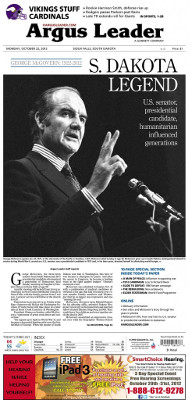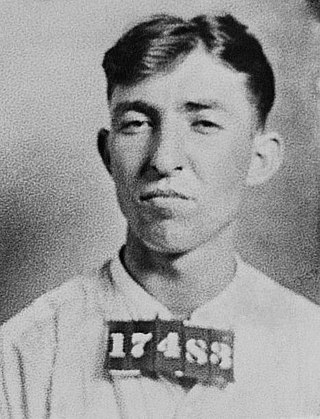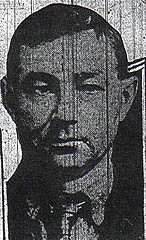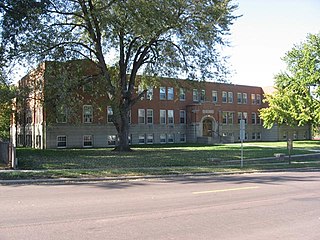
John Herbert Dillinger was an American gangster during the Great Depression. He commanded the Dillinger Gang, which was accused of robbing twenty-four banks and four police stations. Dillinger was imprisoned several times and escaped twice. He was charged with but not convicted of the murder of an East Chicago, Indiana, police officer, who shot Dillinger in his bullet-proof vest during a shootout; it was the only time Dillinger was charged with homicide.

Bank robbery is the criminal act of stealing from a bank, specifically while bank employees and customers are subjected to force, violence, or a threat of violence. This refers to robbery of a bank branch or teller, as opposed to other bank-owned property, such as a train, armored car, or (historically) stagecoach. It is a federal crime in the United States.

Lester Joseph Gillis, also known as George Nelson and Baby Face Nelson, was an American bank robber who became a criminal partner of John Dillinger, when he helped Dillinger escape from prison, in Crown Point, Indiana. Later, the Federal Bureau of Investigation (FBI) announced that Nelson and the remaining gang of bank robbers were collectively "Public Enemy Number One".

Harry "Pete" Pierpont was a Prohibition era gangster, convicted murderer and bank robber. He was a friend and mentor to John Dillinger.

Sioux Falls Regional Airport, also known as Joe Foss Field, is a public and military use airport three miles northwest of Sioux Falls, South Dakota, United States. It is named in honor of aviator and Sioux Falls native Joe Foss, who later served as the 20th Governor of South Dakota (1955–1959).

The Argus Leader is the daily newspaper of Sioux Falls, South Dakota. It is the largest newspaper by total circulation in South Dakota.

Vernon C. "Verne" Miller was a freelance Prohibition hitman, bootlegger, bank robber and the disgraced former sheriff of Beadle County, South Dakota. Most infamously, Miller, as the only identified gunman in the Kansas City massacre, was found beaten and strangled to death shortly after the incident.

Public Enemies is a 2009 American biographical crime drama film directed by Michael Mann, who co-wrote the screenplay with Ronan Bennett and Ann Biderman. It is an adaptation of Bryan Burrough's 2004 non-fiction book Public Enemies: America's Greatest Crime Wave and the Birth of the FBI, 1933–34. Set during the Great Depression, the film chronicles the final years of the notorious bank robber John Dillinger as he is pursued by FBI agent Melvin Purvis, Dillinger's relationship with Billie Frechette, as well as Purvis' pursuit of Dillinger's associates and fellow criminals John "Red" Hamilton, Homer Van Meter, Harry Pierpont, and Baby Face Nelson.

Charles Omer Makley, also known as Charles McGray and Fat Charles, was an American criminal and bank robber active in the early 20th century, most notably as a criminal associate of John Dillinger.

Homer Virgil Van Meter was an American criminal and bank robber active in the early 20th century, most notably as a criminal associate of John Dillinger and Baby Face Nelson.

John "Red" Hamilton was a Canadian criminal and bank robber active in the 1920s–1930s, most notably as an associate of John Dillinger. He is best known for his lingering death and secret burial after being mortally wounded during a robbery.

The Dillinger Gang was a group of American Depression-era bank robbers led by John Dillinger. The gang gained notoriety for a successful string of bank robberies, using modern tools and tactics, in the Midwestern United States from September 1933 to July 1934. During this crime spree, the gang killed 10 and wounded 7. They managed to pull off three jail breaks which wounded two guards and killed a sheriff.

John Paul Chase was an American bank robber and Depression-era outlaw. He was a longtime criminal associate of the Karpis-Barker Gang and most notably Baby Face Nelson who later brought him into the John Dillinger gang. FBI Director J. Edgar Hoover once referred to Chase as "a rat with a patriotic-sounding name". Chase and Nelson continued to rob banks with John Dillinger until Dillinger's death in July 1934. After the death of Nelson in November 1934, Chase fled back to California where he was arrested a month later on December 27, 1934. Chase was sent to Alcatraz where he became one of the longest-serving inmates;.

Thomas Leonard Carroll was an American bank robber and Depression-era outlaw. A boxer-turned-criminal, he committed numerous robberies during the 1920s and 1930s as well as being a longtime member of the Dillinger gang.
Verne Sankey and Gordon Alcorn were a pair of Depression-era outlaws whose successful kidnappings of Haskell Bohn and Charles Boettcher II in 1932 made them two of the most wanted criminals in the United States, and inspired a number of other kidnappings across the country. Their eventual capture was, in fact, a direct result of one of these copycat kidnappings, of which they themselves were wrongly accused. Sankey was initially a suspect in the Lindbergh baby kidnapping, but was cleared after an investigation by the FBI.

Harold Eugene "Eddie" Green was an American bank robber and Depression-era outlaw during the 1930s, best known as a member of the John Dillinger gang. He was also associated with Frank "Jelly" Nash, Volney Davis and the Barker-Karpis Gang in his early career.

Frederick Grant Dunn (1905–1959) was an American criminal, burglar and bank robber whose career spanned over four decades from 1919 until his mysterious death in 1959. He led a small gang during the 1940s and 1950s, Dunn becoming referred to by the press as "the modern John Dillinger", and whose activities eventually resulted in his being listed on the FBI's Ten Most Wanted in 1958.

Herman Karl Lamm, known as Baron Lamm, was a German-American bank robber. A former Prussian Army soldier who immigrated to the United States, Lamm believed a heist required all the planning of a military operation. He pioneered the concepts of "casing" a bank and developing escape routes before conducting the robbery. Using a meticulous planning system called "The Lamm Technique", he conducted dozens of successful bank robberies from the end of World War I.
Pearl Elliott was a notorious madam of Kokomo, Indiana, United States. She was best known as an early associate of the Prohibition era gangster Harry Pierpont and later of the bank robber John Dillinger. Along with the gun moll Mary Kinder, she was one of two women listed on the Chicago Police Department's Public Enemies list in 1933.

The Presentation Children's Home is a historic building at 701 South Western Avenue in Sioux Falls, South Dakota. Built to replace an earlier orphanage in Turton that burned down, it functioned not only as an orphanage—one of the few in South Dakota—but also as a school from its opening in 1940 to its closure in 1966. It was added to the National Register of Historic Places in 1993.





















